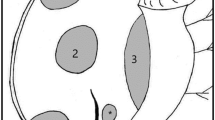Abstract
Purpose of Review
While the safety and efficacy of percutaneous ASD closure has been established, new data have recently emerged regarding the negative impact of residual iatrogenic ASD (iASD) following left heart structural interventions. Additionally, new devices with potential advantages have recently been studied. We will review here the potential indications for closure of iASD along with new generation closure devices and potential late complications requiring long-term follow-up.
Recent Findings
With the expansion of left-heart structural interventions and large-bore transseptal access, there has been growing experience gained with management of residual iASD. Some recently published reports have implicated residual iASD after these procedures as a potential source of diminished clinical outcomes and mortality. Additionally, recent trials investigating new generation closure devices as well as expanding knowledge regarding late complications of percutaneous ASD closure have been published.
Summary
While percutaneous ASD closure is no longer a novel approach to managing septal defects, there are several contemporary issues related to residual iASD following large-bore transseptal access and new generation devices which serve as an impetus for this review. Ongoing attention to potential late complications and decreasing their incidence with ongoing study is clearly needed.



Similar content being viewed by others
References
Papers of particular interest, published recently, have been highlighted as: • Of importance •• Of major importance
Hoffman JI, Kaplan S. The incidence of congenital heart disease. J Am Coll Cardiol. 2002;39(12):1890–900.
Geva T, Martins JD, Wald RM. Atrial septal defects. Lancet. 2014;383(9932):1921–32.
Warnes CA, Williams RG, Bashore TM, Child JS, Connolly HM, Dearani JA, et al. ACC/AHA 2008 guidelines for the management of adults with congenital heart disease: a report of the American College of Cardiology/American Heart Association Task Force on Practice Guidelines (Writing Committee to Develop Guidelines on the Management of Adults With Congenital Heart Disease). Developed in Collaboration with the American Society of Echocardiography, Heart Rhythm Society, International Society for Adult Congenital Heart Disease, Society for Cardiovascular Angiography and Interventions, and Society of Thoracic Surgeons. J Am Coll Cardiol. 2008;52(23):e143–263.
McGinty PM, Smith TW, Rogers JH. Transseptal left heart catheterization and the incidence of persistent iatrogenic atrial septal defects. J Interv Cardiol. 2011;24(3):254–63.
• Schueler R, Öztürk C, Wedekind JA, Werner N, Stöckigt F, Mellert F, et al. Persistence of iatrogenic atrial septal defect after interventional mitral valve repair with the MitraClip system: a note of caution. JACC Cardiovasc Interv. 2015;8(3):450–9. This paper is one of the first to quantify the rates of persistent iASD following MitraClip and importantly characterizes the impact of persistent iASD on clinical outcomes including mortality
•• Turner, D.R., et al., Closure of secundum atrial septal defects with the AMPLATZER septal occluder: a prospective, multicenter, post-approval study. Circ Cardiovasc Interv, 2017. 10(8). This is a post-approval study which validates the previous experience with the AMPLATZER Septal Occluder and confirms its effectiveness and most importantly safety in large cohort of patients followed for 2 years following implantation.
El-Said HG, Moore JW. Erosion by the Amplatzer septal occluder: experienced operator opinions at odds with manufacturer recommendations? Catheter Cardiovasc Interv. 2009;73(7):925–30.
Moore J, Hegde S, el-Said H, Beekman R 3rd, Benson L, Bergersen L, et al. Transcatheter device closure of atrial septal defects: a safety review. JACC Cardiovasc Interv. 2013;6(5):433–42.
Amin Z, Hijazi ZM, Bass JL, Cheatham JP, Hellenbrand WE, Kleinman CS. Erosion of Amplatzer septal occluder device after closure of secundum atrial septal defects: review of registry of complications and recommendations to minimize future risk. Catheter Cardiovasc Interv. 2004;63(4):496–502.
Amin Z. Echocardiographic predictors of cardiac erosion after Amplatzer septal occluder placement. Catheter Cardiovasc Interv. 2014;83(1):84–92.
McElhinney DB, Quartermain MD, Kenny D, Alboliras E, Amin Z. Relative risk factors for cardiac erosion following transcatheter closure of atrial septal defects: a case-control study. Circulation. 2016;133(18):1738–46.
Nyboe C, Olsen MS, Nielsen-Kudsk JE, Hjortdal VE. Atrial fibrillation and stroke in adult patients with atrial septal defect and the long-term effect of closure. Heart. 2015;101(9):706–11.
Vecht JA, Saso S, Rao C, Dimopoulos K, Grapsa J, Terracciano CM, et al. Atrial septal defect closure is associated with a reduced prevalence of atrial tachyarrhythmia in the short to medium term: a systematic review and meta-analysis. Heart. 2010;96(22):1789–97.
Carroll JD, Saver JL, Thaler DE, Smalling RW, Berry S, MacDonald L, et al. Closure of patent foramen ovale versus medical therapy after cryptogenic stroke. N Engl J Med. 2013;368(12):1092–100.
Abaci A, Unlu S, Alsancak Y, Kaya U, Sezenoz B. Short and long term complications of device closure of atrial septal defect and patent foramen ovale: meta-analysis of 28,142 patients from 203 studies. Catheter Cardiovasc Interv. 2013;82(7):1123–38.
Wilson W, Taubert KA, Gewitz M, Lockhart PB, Baddour LM, Levison M, et al. Prevention of infective endocarditis: guidelines from the American Heart Association: a guideline from the American Heart Association Rheumatic Fever, Endocarditis, and Kawasaki Disease Committee, Council on Cardiovascular Disease in the Young, and the Council on Clinical Cardiology, Council on Cardiovascular Surgery and Anesthesia, and the Quality of Care and Outcomes Research Interdisciplinary Working Group. Circulation. 2007;116(15):1736–54.
Author information
Authors and Affiliations
Corresponding author
Ethics declarations
Conflict of Interest
Dominik M. Wiktor has no financial disclosures relevant to the subject matter of this publication.
John D. Carroll served on the steering committee for the clinical trial RESPECT sponsored by St. Jude Medical and Abbott Vascular. Compensation for consulting services rendered in this role was paid to University Physician Inc. of the University of Colorado School of Medicine.
Human and Animal Rights and Informed Consent
This article does not contain any studies with human or animal subjects performed by any of the authors.
Additional information
This article is part of the Topical Collection on Structural Heart Disease
Rights and permissions
About this article
Cite this article
Wiktor, D.M., Carroll, J.D. ASD Closure in Structural Heart Disease. Curr Cardiol Rep 20, 37 (2018). https://doi.org/10.1007/s11886-018-0983-x
Published:
DOI: https://doi.org/10.1007/s11886-018-0983-x




